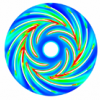I am following setting paths for 3D Objects in my book, what i want todo is add more paths instead of it reseting back to the right hand side of the screen, what do i need to change so the 3D Object goes along all the set paths,thanks for reading
void init_graphics(void)
{
Path[0].x = -2.5f; Path[0].y = 1.0f; Path[0].z = 0.0f;
Path[1].x = 2.5f; Path[1].y = 1.0f; Path[1].z = 0.0f;
Path[2].x = 2.5f; Path[2].y = 1.0f; Path[2].z = 0.0f;
Path[3].x = -2.5f; Path[3].y = 1.0f; Path[3].z = 0.0f;
StartTime = (float)timeGetTime();
// create the vertices using the CUSTOMVERTEX struct
CUSTOMVERTEX vertices[] =
{
{ 1.0f, -1.0f, 0.0f, D3DCOLOR_XRGB(0, 0, 255), },
{ 0.0f, 1.0f, 0.0f, D3DCOLOR_XRGB(0, 255, 0), },
{ -1.0f, -1.0f, 0.0f, D3DCOLOR_XRGB(255, 0, 0), },
};
// create a vertex buffer interface called v_buffer
d3ddev->CreateVertexBuffer(3*sizeof(CUSTOMVERTEX),
0,
CUSTOMFVF,
D3DPOOL_MANAGED,
&v_buffer,
NULL);
VOID* pVoid; // a void pointer
// lock v_buffer and load the vertices into it
v_buffer->Lock(0, 0, (void**)&pVoid, 0);
memcpy(pVoid, vertices, sizeof(vertices));
v_buffer->Unlock();
}
void render_frame(void)
{
d3ddev->Clear(0, NULL, D3DCLEAR_TARGET, D3DCOLOR_XRGB(0, 0, 0), 1.0f, 0);
d3ddev->BeginScene();
// select which vertex format we are using
d3ddev->SetFVF(CUSTOMFVF);
// SET UP THE PIPELINE
D3DXMATRIX matRotateY; // a matrix to store the rotation information
static float index = 0.0f; index+=0.05f; // an ever-increasing float value
// build a matrix to rotate the model based on the increasing float value
D3DXMatrixRotationY(&matRotateY, index);
// tell Direct3D about our matrix
d3ddev->SetTransform(D3DTS_WORLD, &matRotateY);
D3DXMATRIX matView; // the view transform matrix
D3DXMatrixLookAtLH(&matView,
&D3DXVECTOR3 (0.0f, 0.0f, 5.0f), // the camera position
&D3DXVECTOR3 (0.0f, 0.0f, 0.0f), // the look-at position
&D3DXVECTOR3 (0.0f, 1.0f, 0.0f)); // the up direction
d3ddev->SetTransform(D3DTS_VIEW, &matView); // set the view transform to matView
D3DXMATRIX matProjection; // the projection transform matrix
D3DXMatrixPerspectiveFovLH(&matProjection,
D3DXToRadian(45), // the horizontal field of view
(FLOAT)SCREEN_WIDTH / (FLOAT)SCREEN_HEIGHT, // aspect ratio
0.1f, // the near view-plane
100.0f); // the far view-plane
d3ddev->SetTransform(D3DTS_PROJECTION, &matProjection); // set the projection
float Scalar = (float)timeGetTime();
Scalar = (Scalar -StartTime) * 0.0003f;
if(CurrentPath == 1)
{
stVector diff;
diff.x = Path[1].x - Path[0].x;
diff.y = Path[1].y - Path[0].y;
diff.z = Path[1].z - Path[0].z;
float len = (float)sqrt((diff.x * diff.x +
diff.y * diff.y +
diff.z * diff.z));
Scalar = Scalar / len;
objPos.x = (Path[1].x - Path[0].x) * Scalar + Path[0].x;
objPos.y = (Path[1].y - Path[0].y) * Scalar + Path[0].y;
objPos.z = (Path[1].z - Path[0].z) * Scalar + Path[0].z;
}
else
{
stVector diff;
diff.x = Path[3].x - Path[2].x;
diff.x = Path[3].y - Path[2].y;
diff.x = Path[3].z - Path[2].z;
float len = (float)sqrt((diff.x * diff.x +
diff.y * diff.y +
diff.z * diff.z));
Scalar = Scalar / len;
objPos.x = (Path[3].x - Path[2].x) * Scalar + Path[2].x;
objPos.y = (Path[3].y - Path[2].y) * Scalar + Path[2].y;
objPos.z = (Path[3].z - Path[2].z) * Scalar + Path[2].z;
}
if(Scalar >= 1.0f)
{
StartTime = (float)timeGetTime();
CurrentPath++;
if(CurrentPath > 2) CurrentPath = 1;
}
D3DXMATRIX mat;
//D3DXMatrixIdentity(&mat);
D3DXMatrixTranslation(&mat,objPos.x,objPos.y,objPos.z);
d3ddev->SetTransform(D3DTS_WORLD,&mat);
// select the vertex buffer to display
d3ddev->SetStreamSource(0, v_buffer, 0, sizeof(CUSTOMVERTEX));
// copy the vertex buffer to the back buffer
d3ddev->DrawPrimitive(D3DPT_TRIANGLELIST, 0, 1);
d3ddev->EndScene();
d3ddev->Present(NULL, NULL, NULL, NULL);
}



